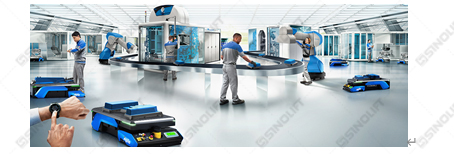The automation of internal logistics refers to the use of advanced technology and equipment to automate the material
transportation, storage and handling logistics activities within the enterprise, in order to improve efficiency, reduce costs
and enhance the accuracy of management. It mainly includes the following aspects:
Automatic transmission system (ATS): This includes unmanned guide vehicle (AGV), conveyor belt, automatic stereo
warehouse, etc. These systems can automatically transfer materials from one place to another, reducing the need for
manual handling.
Automatic Storage and Retrieval System (AS / RS): This is an automated system including shelves, forklifts and control
systems for the automatic storage and retrieval of goods. It can greatly improve the space utilization rate and work
efficiency of the warehouse.
Automatic picking system: This includes automatic picking robots based on machine vision, mechanical arm and other
technologies, which can automatically pick goods from the shelves according to the demand.
Logistics information system: This includes warehouse management system (WMS), transportation management system
(TMS), etc., to provide decision support for the whole logistics activities through real-time data collection, analysis and optimization.
Automated packaging and marking systems: such as automated packaging lines, automatic label printing, and application
systems, which can improve the speed and accuracy of packaging.
Integration of Material Requirements Plan (MRP) and Enterprise Resource Planning (ERP) systems: This ensures that
production and supply chain activities match actual demand and inventory levels, reducing waste and improving efficiency.
Application of the Internet of Things (IoT) technology: through sensors, RFID and other technologies, real-time monitoring
of the status and location of materials, to provide data support for management and decision-making.
The automation of internal logistics can bring many benefits to enterprises, such as improving efficiency, reducing labor
costs, reducing errors, improving security and so on. As technology advances, we can expect more innovations and applications
in this field.

|  Business Line: 4007-166-180
Business Line: 4007-166-180 Tel£º+86 21 58003681
Tel£º+86 21 58003681 Fax£º+86 21 68014262
Fax£º+86 21 68014262 Website£ºhttp://www.sinoliftdrum.com
Website£ºhttp://www.sinoliftdrum.com Email£ºdrum@sinolift.com
Email£ºdrum@sinolift.com  Skype£ºsinolift
Skype£ºsinolift Business Line: 4007-166-180
Business Line: 4007-166-180 Tel£º+86 21 58003681
Tel£º+86 21 58003681 Fax£º+86 21 68014262
Fax£º+86 21 68014262 Website£ºhttp://www.sinoliftdrum.com
Website£ºhttp://www.sinoliftdrum.com Email£ºdrum@sinolift.com
Email£ºdrum@sinolift.com  Skype£ºsinolift
Skype£ºsinolift